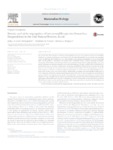Use este identificador para citar ou linkar para este item:
http://www.alice.cnptia.embrapa.br/alice/handle/doc/1065284Registro completo de metadados
| Campo DC | Valor | Idioma |
|---|---|---|
| dc.contributor.author | FERREGUETTI, A. C. | pt_BR |
| dc.contributor.author | TOMAS, W. M. | pt_BR |
| dc.contributor.author | BERGALLO, H. G. | pt_BR |
| dc.date.accessioned | 2017-02-22T11:11:11Z | pt_BR |
| dc.date.available | 2017-02-22T11:11:11Z | pt_BR |
| dc.date.created | 2017-02-22 | pt_BR |
| dc.date.issued | 2016 | pt_BR |
| dc.identifier.citation | Mammalian Biology, v.81, p. 138-145, 2016. | pt_BR |
| dc.identifier.uri | http://www.alice.cnptia.embrapa.br/alice/handle/doc/1065284 | pt_BR |
| dc.description | We provide the first estimates of density and population size of two sympatric species of armadillos (Euphractus sexcinctus and Dasypus novemcinctus) for the Vale Natural Reserve, evaluating how poaching would be affecting their habitat use (i.e. detectability and occupancy probability) and also describing their activity patterns. Abundance and density were estimated using a distance sampling technique. Occupancy, detectability, and activity patterns were assessed using camera-trapping during a one-year period. Estimated population densities were 0.06 individuals per hectare (ind/ha) and 0.05 ind/ha for D. novemcinctus and E. sexcinctus, espectively. Occupancy probability of both species was affected by the distance to forest edge. D. novemcinctus showed a positive relationship with increasing distance from the edge, whereas E. sexcinctus showed an opposite relationship. D. novemcinctus also showed higher occupancy rates in sites closer to a water resource. Additionally, occupancy and detectability of both species were negatively affected by historical poaching intensity in the reserve. Activity patterns varied between species, with D. novemcinctus being mostly nocturnal and E. sexcinctus being diurnal. We conclude that despite the two armadillo species sharing several niche dimensions, they showed spatial and temporal segregation. These differences may be an adaptation to reduce interspecific competition but may also be affected by the need to avoid poaching pressures. This study contributes to increase the knowledge and conservation of these two little-studied species. | pt_BR |
| dc.language.iso | eng | eng |
| dc.rights | openAccess | eng |
| dc.subject | Atlantic Forest | pt_BR |
| dc.subject | Euphractus sexcinctus | pt_BR |
| dc.subject | Population distribuition | pt_BR |
| dc.title | Density and niche segregation of two armadillo species (Xenarthra: Dasypodidae) in the Vale Natural Reserve, Brazil. | pt_BR |
| dc.type | Artigo de periódico | pt_BR |
| dc.date.updated | 2017-07-25T11:11:11Z | pt_BR |
| dc.subject.thesagro | Dinamica populacional | pt_BR |
| dc.subject.thesagro | Dasypus Novemcinctus | pt_BR |
| dc.subject.nalthesaurus | Species dispersal | pt_BR |
| dc.subject.nalthesaurus | Camera trapping | pt_BR |
| riaa.ainfo.id | 1065284 | pt_BR |
| riaa.ainfo.lastupdate | 2017-07-25 | pt_BR |
| dc.contributor.institution | ATILLA COLOMBO FERREGUETTI, Rio de Janeiro State University- Department of Ecology; WALFRIDO MORAES TOMAS, CPAP; HELENA G. BERGALLO, Rio de Janeiro State University- Department of Ecology. | pt_BR |
| Aparece nas coleções: | Artigo em periódico indexado (CPAP)  | |
Arquivos associados a este item:
| Arquivo | Descrição | Tamanho | Formato | |
|---|---|---|---|---|
| 1s2.0S1616504715001056main.pdf | 1,42 MB | Adobe PDF |  Visualizar/Abrir |









